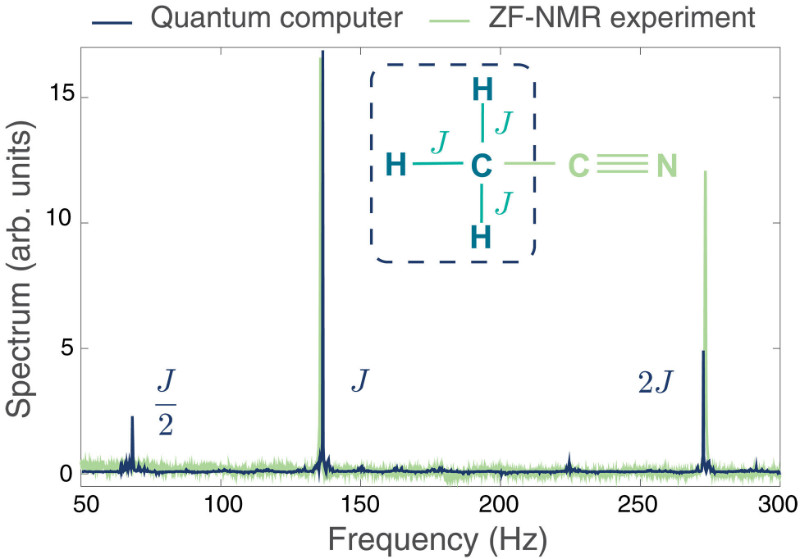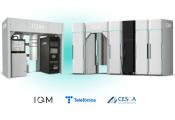Digital Quantum Simulation of Nuclear Magnetic Resonance Experiments
October 14, 2024 -- Programmable quantum computers have the potential to efficiently simulate increasingly complex molecular structures, electronic structures, chemical reactions, and quantum mechanical states in chemistry that classical computers cannot. As the molecule's size and complexity increase, so do the computational resources required to model it.

For example, it could take thousands to millions of years, even with the world's most advanced classical supercomputers, to simulate essential molecules for drug discovery.
Indeed, chemistry has emerged as one of the most compelling applications of near-term quantum devices. Given their ability to process information in qubits, quantum processors are naturally suited for simulating the dynamics of complex and highly correlated quantum systems.
Nuclear magnetic resonance (NMR) is a key structural characterization technique in biology, chemistry, and materials science that gathers structural information about atoms and their arrangement in space. However, interpreting the results can be challenging. This is especially true for zero-field NMR experiments which remove the large magnet used in conventional NMR experiments.
The quantum simulation of NMR, however, enables the possibility of mimicking the noisy dynamics of one system with the dynamics of another.
An interdisciplinary collaboration by Quantum Systems Accelerator (QSA) researchers at the Massachusetts Institute of Technology, Harvard University, University of Maryland, and Duke University demonstrated a zero-field NMR digital quantum simulation experiment on a programmable trapped-ion processor.
The team used four qubits to compute the zero-field NMR spectrum of the methyl group of acetonitrile for the first time, a simple organic compound used in many products, including pharmaceuticals, pesticides, plastics, and batteries. Furthermore, researchers deployed compressed sensing techniques to obtain accurate results in less time and with less computational resources.
This novel experimental work, published in 2023 in Science Advances, paves the way for finding exciting practical uses of near-term quantum devices.
"Tailoring the algorithmic and hardware approaches to the structure of NMR systems may enable resource-efficient simulations on near-term devices, thereby opening specific biochemistry analysis pipelines. The breadth and depth of the QSA community provide a fertile ground for the multidisciplinary collaborative efforts required to realize the potential of this application," said Kushal Seetharam, postdoctoral fellow at Harvard University and lead paper author.
QSA, in parallel, is further developing quantum devices based on arrays of neutral atoms with pioneering methods for control and fast readout for complex molecular simulations. A multi-institution team led by QSA researchers at Harvard University published a theoretical framework for simulating strongly correlated quantum systems in chemistry using Rydberg atom arrays.
The authors published their study last December, offering a flexible quantum toolbox for simulating the time evolution of spin Hamiltonians (mathematical models of quantum systems). Using a mix of computational approaches and engineering methods, including hardware-specific multi-qubit gates for the Rydberg atom arrays, researchers showed how to optimize hardware operations to accurately simulate complex interactions between spins.
Using hybrid quantum-classical computing techniques, they also introduced an algorithm from near-term quantum experiments, enabling predictions of key quantities, such as how energy and temperature changes could influence the chemical properties and behavior of molecules and atoms.
"Neutral atom arrays have undergone rapid experimental progress in recent years, and here, we show how these novel architectures can be applied to accelerate classically challenging simulations of quantum systems. The collaborations facilitated by the QSA are crucial for pursuing this interdisciplinary research," explained Nishad Maskara, Ph.D. researcher at Harvard and lead paper author.
Researchers further suggested that this framework could study exotic materials, such as transition metal compounds with complex magnetic properties. These compounds appear in various contexts, including catalysis in biological systems. Further, simulations of 2D or 3D transition metal materials could provide clues to some of the fabrication and material challenges of quantum processors currently using conventional materials.
"The ability to perform detailed and accurate quantum simulations will be invaluable for chemists and material scientists as they try to understand experimental results and design new compounds with interesting properties," said Maskara.
Computational simulation in classical computers has been limited by the exponentially large number of possible state configurations required to interpret the nuclear spin system for large molecules, proteins, and protocols. Therefore, complex simulations in chemical science are ideal for tackling with a quantum computer.
Through collaboration, QSA continues to drive innovation in quantum prototypes and algorithms for fundamental science, especially complex chemistry, across all partner institutions. Harvard researchers are currently exploring how to advance the quantum simulation of the NMR experiment with a toolbox of protocols using reconfigurable quantum processors.
"Guided by a science-first approach since 2020, QSA has developed scalable quantum systems and prototypes that will pave the way for groundbreaking discoveries across various hardware platforms, algorithms, and science applications," said Sandia National Laboratories' Daniel Stick, QSA's deputy director.




































